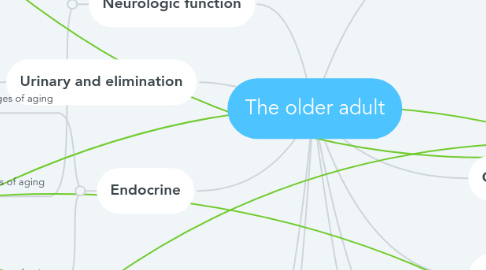
1. Neurologic function
1.1. Normal changes of aging
1.1.1. Atrophy of brain and spinal cord
1.1.2. Slow nerve conduction
1.1.3. Decreased cerebral blood flow
1.1.4. Decrease in number and sensitivity of sensory receptors, dermatitis, and neurons
1.1.4.1. Decline in touch, taste, smell
1.1.5. Decrease in intellectual performance and verbal skills
1.1.6. Presbyopia
1.1.7. Increased time to adapt to dark and light
1.1.7.1. Reduced pupil size
1.1.8. Low tear production
1.1.8.1. Dry eyes
1.1.9. Presbycusis
1.1.9.1. Can effect speech
1.1.10. Extra cerumen
1.2. Pathological changes of aging
1.2.1. Cerebrovascular accidents
1.2.1.1. Loss of oxygen to brain tissue resulting in possible hemiplegia, aphasia, hemianopia
1.2.2. Glaucoma, acute
1.2.2.1. Damaged optic nerve from increased IOP
1.2.2.1.1. Leading cause of blindness
2. Urinary and elimination
2.1. Normal changes of aging
2.1.1. Urinary
2.1.1.1. Ineffective filtration of drugs and wastes from blood due to 50% loss of nephrons
2.1.1.2. Decreased resorption of glucose
2.1.1.3. Increased urinary frequency
2.1.1.4. Weaker bladder muscles
2.1.1.5. Decreased bladder capacity
2.1.1.6. Prostate enlargement
2.1.1.7. Incomplete emptying of bladder/ urinary retention
2.1.2. Elimination/digestion
2.1.2.1. Presbyesophagus
2.1.2.2. Decrease in bile synthesis
2.1.2.3. Reduced hepatic blood flow
2.1.2.4. Incomplete emptying of the bowel
2.1.2.5. Reduction of pepsin
2.1.2.6. Decreased elasticity of the stomach
2.1.2.7. Decrease in saliva production
2.1.2.8. Decreased absorption
2.1.2.9. Decreased appetite
2.2. Pathological changes of aging
2.2.1. Digestion/elimination
2.2.1.1. Periodontal disease
2.2.1.1.1. Infection of the gums, can lead to systemic infection in older adults
2.2.2. Urinary
2.2.2.1. Bladder cancer
2.2.2.1.1. Causes: chronic bladder irritation
3. Endocrine
3.1. Normal changes of aging
3.1.1. Atrophied thyroid gland
3.1.1.1. Lower basal metabolic rate
3.1.2. Reduced adrenal gland function
3.1.2.1. Reduced estrogen, progesterone, androgen, glucocorticoids
3.1.3. Reduced insulin release
3.1.4. Reduced tissue sensitivity to insulin
3.1.4.1. Reduced ability to metabolize glucose
3.1.5. Pituitary gland atrophy
3.2. Pathological changes of aging
3.2.1. Diabetes mellitus
3.2.1.1. The inability of the cells to uptake glucose out of the blood stream related too poor insulin function
3.2.1.1.1. Hypoglycemia
3.2.1.1.2. Hyperglycemia
3.2.1.1.3. Can result in high bp, delayed wound healing, decreased blood flow/ oxygenation to tissues, neuropathy, loss of limbs
3.2.2. Hypothyroidism
3.2.2.1. Decreased T3 and T4
3.2.2.1.1. Fatigue, weakness, lethargy, depression, disinterest in activities, anorexia, weight gain, impaired hearing, constipation, cold intolerance, myalgia, dry skin, coarse hair, periorbital and peripheral edema
4. Reproductive
4.1. Male
4.1.1. Normal changes of aging
4.1.1.1. Andropause
4.1.1.1.1. Decline in testosterone
4.1.1.2. Decreased capacity to retain fluids
4.1.1.3. Ejaculation fluid contains less live sperm
4.1.1.4. Enlargement of prostate gland
4.1.1.5. Atrophy of testes and reduction of testicular mass
4.1.1.6. More time required to get an erection
4.2. Female
4.2.1. Normal changes of aging
4.2.1.1. Menopause
4.2.1.1.1. Estrogen levels fall, menses cease
4.2.1.2. Vulva atrophies
4.2.1.3. Flattening of labia
4.2.1.4. Loss of subcutaneous fat and hair
4.2.1.5. Cervix, uterus, and Fallopian tubes atrophy
4.2.1.6. Vaginal epithelium thins
4.2.1.7. Less lubrication, more alkaline ph
4.3. Pathological changes of aging
4.3.1. Prostate cancer
4.3.1.1. Back pain, anemia weakness, weight loss
4.3.1.1.1. Confirmed with biopsy
4.3.2. Ovarian cancer
4.3.2.1. S&S: GI discomfort, bleeding, ascites, presence of a mass
4.3.2.1.1. Cancer treatment
5. Immune system
5.1. Pathological changes of aging
5.1.1. Urinary tract infection
5.1.1.1. Bacteria in the urinary tract
5.1.1.1.1. Caused by urinary retention, incomplete voiding, wiping back to front, low fluid intake, excessive fluid loss, hormone changes.
5.2. Normal changes of aging
5.2.1. Increased susceptibility to infection
5.2.2. Decrease in size of thymus gland
5.2.3. Increased number of immature t cells
5.2.4. T cell function declines
5.2.5. Reduced antibody response
5.2.6. Reduced thickness of skin
5.2.7. Decreased circulation to the skin
6. Respiratory
6.1. Normal changes of aging
6.1.1. Reduction in vital capacity
6.1.2. Decreased elastic recoil
6.1.3. Calcification if the trachea and larynx
6.1.4. Increased residual capacity
6.1.5. Less efficient cough response
6.1.6. Reduced number and elasticity of alveoli
6.1.7. Reduced elastic recoil of lungs during expiration
6.2. Pathological changes of aging
6.2.1. COPD
6.2.1.1. Combination of chronic bronchitis and emphysema
6.2.1.1.1. S&S : barrel chest, reoccurring respiratory infections, episodes of hypoxia
6.2.2. Pneumonia
6.2.2.1. Infection in lungs
6.2.2.1.1. S&S: slight cough, fatigue, rapid breathing, confusion, restlessness, cerebral hypoxia
7. Cardiovascular
7.1. Normal changes of aging
7.1.1. Decreased elasticity of blood vessels
7.1.2. Increased resistance of peripheral vessels
7.1.3. Decreased coronary blood flow
7.1.4. Reduced proportion of oxygen extracted from arterial blood tissues
7.1.5. Reduced cardiovascular responsiveness to adrenergic stimulation
7.2. Pathological changes of aging
7.2.1. Peripheral vascular disease
7.2.1.1. Caused by arteriosclerosis,
7.2.1.1.1. Restricts blood flow in peripheral vessels
7.2.2. Coronary artery disease
7.2.2.1. Buildup of plaque in arteries
7.2.2.1.1. Reduction of blood flow to the heart
7.2.2.2. S&S
7.2.2.2.1. Angina, myocardial infarction, radiating pain in left arm, shortness of breath, chest pain
8. Integumentary
8.1. Normal changes of aging
8.1.1. Flattening of dermal/ epidermal junction
8.1.2. Reduced thickness and vascularity of dermis,
8.1.3. Decreased epidermal turnover
8.1.4. Coarseness and decrease in collagen
8.1.5. Reduction of melanocytes
8.1.6. Increased risk of skin tears, bruising, skin infections
8.1.7. Decreased elasticity
8.2. Pathological changes of aging
8.2.1. Puritis
8.2.1.1. Caused by any circumstance that dries the persons skin
8.2.1.1.1. Itching
8.2.2. Skin cancer
8.2.2.1. Cancer in various layers of dermis
8.2.2.1.1. Lack of melanin
9. Sleep and rest
9.1. Normal changes of aging
9.1.1. Sleep latency
9.1.2. Phase advance
9.1.3. Insomnia
10. Musculoskeletal
10.1. Normal changes of aging
10.1.1. Decrease in muscle mass, strength, movements
10.1.1.1. Limited mobility
10.1.2. Deterioration of cartilage
10.1.3. Demineralization of bone
10.1.4. Decreased cardiac output
10.2. Pathological changes of aging
10.2.1. Osteoporosis
10.2.1.1. Brittle bones because of reduced bone mass and poor absorption of vitamin d and calcium
10.2.1.1.1. Bone fractures, loss of height
10.2.2. Osteoarthritis
10.2.2.1. Progressive deterioration of joint cartilage because of disequilibrium between bone building and breaking enzymes leading to lack of cartilage maintenance
10.2.2.1.1. S&S: joint pain,
